Determining the Boundaries of Overlying Strata Collapse Above Mined-Out Panels of Zhomart Mine Using Seismic Data
Abstract
:1. Introduction
2. Geological Conditions
3. The Technology of Mining and Rock Pressure Manifestations Observed in Practice
- A high horizontal tectonic stress level, which leads to Eulerian instability of the roof of drifts and chambers in the form of longitudinal bending followed by fracture of thin-slab rocks;
- Opening up of tectonic fault zones by the underground workings, through which groundwater flows into the mine from the overlying aquifer while gray-colored siltstones and mudstones sharply lose strength and stability when flooded.
- A large number of local areas with extraction of interchamber pillars (IPs) with small spans of collapse, and areas between them being overloaded by the bearing pressure;
- Hanging of the rock mass in an unmined barrier and interchamber pillars (BP + IP), creating bearing pressure on them and the surrounding rock mass [35]:
4. Materials and Methods
- Preliminary and standard kinematic processing;
- Detailed kinematic and dynamic interpretations.
- Input of the benchmark data and addition to a unified coordinate system;
- Development of a seismic line and borehole grid;
- Reflection correlation; correlation of well logging data;
- Combination of drilling and seismic exploration data; time depth conversions;
- Calculation of seismic attributes; seismic inversion;
- Development of correlation patterns.
5. Results
- Identify structural-lithological heterogeneities in the intrawell space and undeveloped zones of ore arrays along the seismic profiles to depths more than 1000 m;
- Identify abnormal zones to assess the current geomechanical conditions of the rock mass over the mined-out areas of Zhomart mine and the associated processes of displacement, subsidence, and destruction of the rock mass.
6. Discussion
7. Conclusions
Author Contributions
Funding
Data Availability Statement
Conflicts of Interest
References
- Barry, H.G.; Brown, E.T. Rock Mechanics: For Underground Mining; Springer: Dordrecht, The Netherlands, 2004. [Google Scholar]
- Makarov, A.B. Practical Geomechanics. A Manual for Mining Engineers; Gornaya Kniga: Moscow, Russia, 2006. [Google Scholar]
- Dmitrak, Y.V.; Logacheva, V.M.; Podkolzin, A.A. Geophysical prediction of disturbance and watercut of rock mass. Min. Inf. Anal. Bull. 2006, 11, 35–36. [Google Scholar]
- Istekova, S.A. Modern methods of analysis and interpretation of geophysical data. Proc. Natl. Acad. Sci. Repub. Kazakhstan Geol. Ser. 2006, 4, 1–13. [Google Scholar]
- Kharisov, T.F.; Melnik, V.V.; Kharisova, O.D.; Zamyatin, A.L. Geophysical studies of rock masses in underground mine conditions. Min. Inf. Anal. Bull. 2020, 3, 255–263. [Google Scholar] [CrossRef]
- Shevchenko, M.D. Study of changes in rock mass in the area of influence of underground mine workings. Probl. Subsoil Use 2021, 4, 1–6. [Google Scholar]
- Golik, V.I.; Burdzieva, O.G.; Dzeranov, B.V. Geophysical monitoring of development of stressed-strained ore-bearing mass. Geol. Geophys. South Russ. 2021, 11, 63–70. [Google Scholar]
- Shevchenko, M.D.; Melnik, V.V.; Zamyatin, A.L. Geophysical research at the construction and operation sites of underground mines. Probl. Subsoil Use 2023, 1, 105–112. [Google Scholar]
- Sheriff, R.E.; Geldart, L.P. Exploration Seismology; Cambridge University Press: Cambridge, UK, 1995. [Google Scholar]
- Herwanger, J.; Koutsabeloulis, N. Seismic Geomechanics (How to Build and Calibrate Geomechanical Moduls Using 3D and 4D Seismic Data); European Association of Geoscientists & Engineers: Utrecht, The Netherlands, 2014; ISBN 978-90-73834-10-1. [Google Scholar]
- Karaev, N.A.; Rabinovich, G.Y. Ore Seismic Exploration; Geoinformmark: Moscow, Russia, 2000; 366p. [Google Scholar]
- Evans, B.J. A Handbook for Seismic Data Acquisition in Exploration; Society of Exploration Geophysicists: Tulsa, OK, USA, 1997. [Google Scholar]
- van Buren, R.; Turner, G.; Hird, G. Modern Seismic Is Illuminating the Depths; The Southern African Institute of Mining and Metallurgy: Johannesburg, South Africa, 2019. [Google Scholar]
- Togizov, K.; Issayeva, L.; Muratkhanov, D.; Kurmangazhina, M.; Swęd, M.; Duczmal-Czernikiewicz, A. Rare earth elements in the Shok-Karagay ore fields (Syrymbet ore district, Northern Kazakhstan) and visualisation of the deposits using the Geography Information System. Minerals 2023, 13, 1458. [Google Scholar] [CrossRef]
- Karaev, N.A. Establishment and Methods of Development of Seismic Exploration of Unconventional Models of Upper Crust and Capabilities of Modern Seismoacoustic Technologies in Wide-Exploration Provinces; Seismic Technologies: Chennai, India, 2017. [Google Scholar]
- Malehmir, A.; Durrheim, R.; Bellefleur, G.; Urosevic, M.; Juhlin, C.; White, D.J.; Milkereit, B.; Campbell, G. Seismic methods in mineral exploration and mine planning: A general overview of past and present case histories and a look into the future. Geophysics 2012, 77, WC173–WC190. [Google Scholar] [CrossRef]
- Melnik, V.V. Application of spectral seismic profiling method to assess geomechanical conditions of rock mass around mine workings. Min. Inf. Anal. Bull. 2005, 10, 69–74. [Google Scholar]
- Pisetsky, V.B.; Lapin, S.E.; Zudilin, A.E.; Patrushev, Y.V.; Schneider, I.V. Methodology and results of industrial use of MIKON-GEO seismic monitoring system to control rock mass conditions in the process of underground mining of ore and coal deposits. Min. Inf. Anal. Bull. 2016, 2, 58–64. [Google Scholar]
- Zhukov, A.A.; Prigara, A.M.; Tsarev, R.I.; Shustkina, I.Y. Method of mine seismic exploration to study the features of geological structure of VKMS. Min. Inf. Anal. Bull. 2019, 4, 121–136. [Google Scholar] [CrossRef]
- Malehmir, A.; Markovic, M.; Marsden, P.; Gil, A.; Buske, S.; Sito, L.; Luth, S. Sparse 3D reflection seismic survey for deep-targeting iron oxide deposits and their host rocks. Ludvika Mines Swed. Solid Earth 2021, 12, 483–502. [Google Scholar] [CrossRef]
- An, E.A.; Istekova, S.A.; Kasymkanova, K.M.; Dzhangulova, G.K. Use of 3D seismic exploration for ore deposits modeling in complicated mining geological environment of Kazakhstan. Vestnik RAEN 2021, 1, 15–23. [Google Scholar]
- Zhezkazgan Field. Kazakhstan National Encyclopedia; Kazak encyclopedias: Almaty, Kazakhstan, 2005; Volume II, ISBN 9965-9746-3-2. [Google Scholar]
- Uzhkenov, B.S.; Alzhanova, B.G.; Petrovskiy, V.B.; Fishman, I.L.; Yugin, V.V. Innovative technical schemes for prospecting activities for the deposits of copper of Zhezkazgan type. Kazakhstan 2011, 3, 74–78. [Google Scholar]
- Satpayeva, M.K. Mineralogy of ore deposits of Zhaman-Aybat deposit. News NAS RK Geol. Ser. 2006, 5, 29–41. [Google Scholar]
- Istekova, S.; Aidarbekov, Z.; Togizov, K.; Saurykov, Z.; Sirazhev, A.; Tolybayeva, D.; Temirkhanova, R. Lithophysical characteristics of productive strata of cupriferous sandstone within Zhezkazgan Ore District in the central Kazakhstan. Min. Miner. Depos. 2024, 18, 9–17. [Google Scholar] [CrossRef]
- Aidarbekov, Z.K.; Istekova, S.A.; Glass, H. Complex of geophysical research for studying geological structure of Zhezkazgan ore region in Kazakhstan. In Proceedings of the 17th Conference and Exhibition Engineering and Mining Geophysics, Gelendzhik, Russia, 26–30 April 2021; pp. 1–9. [Google Scholar]
- Pysmennyi, S.; Fedko, M.; Chukharev, S.; Rysbekov, K.; Kyelgyenbai, K.; Anastasov, D. Technology for mining of complex-structured bodies of stable and unstable ores. IOP Conf. Ser. Earth Environ. Sci. 2022, 970, 012–040. [Google Scholar] [CrossRef]
- Zharaspaev, M.A. Experience of Panel-and-Pillar Mining System Application at Zhaman-Aybat Field (Republic of Kazakhstan) Center of Scientific Cooperation “Interactive Plus”; Interactive Science: Englewood, CO, USA, 2017. [Google Scholar]
- Zharaspaev, M.A. Results of Pilot Work on Re-Development at Zhaman-Aybat Field (Republic of Kazakhstan); Interactive Science: Englewood, CO, USA, 2017; pp. 127–132. [Google Scholar]
- Bekbergenov, D.; Jangulova, G.; Kassymkanova, K.K.; Bektur, B. Mine technical system with repeated geotechnology within new frames of sustainable development of underground mining of caved deposits of Zhezkazgan field. Geod. Cartogr. 2020, 46, 182–187. [Google Scholar] [CrossRef]
- Makarov, A.B.; Mosyakin, D.V.; Karpikov, A.A. Assessment of natural stress state of rock mass at Zhaman-Aybat mine. Min. J. 2005, 9–10. [Google Scholar]
- Makarov, A.B.; Selivanov, D.A. Tectonophysical analysis of natural stress field at Zhomart mine. In Development of Mineral Resource Deposits and Underground Construction in Challenging Hydrogeological Conditions; Publishing House Belgorod National Research University BelSU: Belgorod, Russia, 2019; pp. 233–244. [Google Scholar]
- Makarov, A.B.; Mosyakin, D.V.; Tolysbaev, A.K. Movement of rocks during repeated development of flat ore deposits. In Proceedings of the VIII International Conference “Innovative Directions in Design of Mining Enterprises. Geomechanical Support for Design and Support of Mining Operations”—St. Petersburg Mining University, Saint Petersburg, Russia, 15–17 January 2017; pp. 63–70. [Google Scholar]
- Asanov, V.N.; Toksarov, N.A.; Samodelkina, N.L.; Bel’tiukov, A.A.; Udartsev, V.A. Evaluation of stressed-deformed state of virgin rock at Zhaman-Aybat deposit. Bull. PNIPU Geol. Oil Gas Min. 2014, 12, 56–66. [Google Scholar]
- Makarov, A.B.; Selivanov, D.A. An Integrated Approach to Geomechanical Substantiation of Design of Mine Workings Based on Structural-Geological and Tectonophysical Analyzes of Zhaman-Aybat Deposit (Zhomart Mine); Modern Tectonophysics. Methods and Results. Materials of the Sixth Youth Tectonophysical School-Seminar: Moscow, Russia, 2019; pp. 222–229. [Google Scholar]
- Shiri, Y.; Shiri, A. Discrete fracture network (DFN) model-ling of fractured reservoir based on geomechanical restoration, a case study in the South of Iran. Rudarsko-Geološko-Naftni Zbornik 2021, 36, 151–162. [Google Scholar] [CrossRef]
- Makarov, A.; Mosyakin, D. Rock mechanics of pillars extraction EUROCK 2018: Geomechanics and Geodynamics of Rock Masses. In Proceedings of the 2018 European Rock Mechanics Symposium, Saint Petersburg, Russia, 22–26 May 2018; CRC Press: London, UK, 2018; Volume 1, p. 1046. [Google Scholar]
- Fedorov, E.; Kassymkanova, K.K.; Jangulova, G.; Miletenko, N. The influence of extensive caving zones on the state and behavior of the surface as a result of underground mining works. E3S Web Conf. 2020, 192, 03009. [Google Scholar] [CrossRef]
- Makarov, A.B. Reverse calculation of the strength of an ore mass based on destruction of inter-chamber pillars. In Geotechnology-2013: Problems and Ways of Innovative Development of Mining Industry, Proceedings of the VI International Scientific and Practical Conference, Almaty, Kazakhstan, 17 May 2013; IAAR Publications: Kazakhstan, Astana, 2013; Volume 64, pp. 189–194. [Google Scholar]
- Klyuev, R.V.; Bosikov, I.I.; Mayer, A.V.; Gavrina, O.A. Comprehensive analysis of use of effective technologies to improve sustainable development of natural and technical system. Sustain. Dev. Mt. Territ. 2020, 2, 283–290. [Google Scholar] [CrossRef]
- Golik, V.I.; Burdzieva, O.G.; Dzeranov, B.V. Control of rock mass geomechanics by optimizing development technology. Geol. Geophys. South Russ. 2020, 1, 127–137. [Google Scholar]
- Istekova, S.A.; An, E.A. On the use of high-resolution 3D seismic exploration in ore deposits of Kazakhstan. In Proceedings of the Annual International Scientific and Practical Conference “Satpayev Readings”, Almaty, Kazakhstan, 10–11 April 2019; Volume 1, pp. 54–62. [Google Scholar]
- Sirazhev, A.N.; Istekova, S.A.; Temirkhanova, R.G. Application of 3D seismic for justification and characterization of geological and geophysical conditions in mining geology. Eng. Min. Geophys. 2021, 2021, 1–10. [Google Scholar]
- Istekova, S.A.; Sirazhev, A.N.; Temirkhanova, R.G. Geological and geophysical conditions for the use of 3D seismic prospecting in solving problems of ore geology. In Proceedings of the Engineering and Mining Geophysics 2021, Gelendzhik, Russia, 26–30 April 2021; Volume 2021, pp. 13–21. [Google Scholar]
- Sirazhev, A.; Istekova, S. Geological and geophysical conditions for application of 3D seismic in mineral exploration. In Proceedings of the NSG2021 2nd Conference on Geophysics for Infrastructure Planning, Monitoring and BIM, Bordeaux, France, 29 August–2 September 2021; Volume 1, pp. 1–5. [Google Scholar]
- Kasymkanova, K.M.; Istekova, S.A.; An, E.A. A Method for Identifying of Ore Objects Based on 3D Seismic Exploration; Author Certificate No. 109832; National Institute of Intellectual Propert: Astana, Kazakhstan, 2020. [Google Scholar]
- Kassymkanova, K.K.; Istekova, S.; Rysbekov, K.; Amralinova, B.; Kyrgizbayeva, G.; Soltabayeva, S.; Dossetova, G. Improving a geophysical method to determine the boundaries of ore-bearing rocks considering certain tectonic disturbances. Min. Miner. Depos. 2023, 17, 17–27. [Google Scholar] [CrossRef]
- Niyaz, A.T.; Togizov, K.S.; Istekova, S.A. Seismic data dynamic interpretation in the study of the lateral variability of petroleum bearing terrigenous reservoirs. News Natl. Acad. Sci. Repub. Kazakhstan Ser. Geol. Tech. Sci. 2023, 6, 145–156. [Google Scholar] [CrossRef]
- Olierook, H.K.; Scalzo, R.; Kohn, D.; Chandra, R.; Farahbakhsh, E.; Clark, C.; Müller, R.D. Bayesian geological and geophysical data fusion for the construction and uncertainty quantification of 3D geological models. Geosci. Front. 2021, 12, 479–493. [Google Scholar] [CrossRef]
- Hilterman, F.J. Seismic Amplitude Interpretation; Society of Exploration Geophysicists and European Association of Geoscientists and Engineers: Utrecht, The Netherlands, 2001; ISBN 1-56080-109-3. [Google Scholar]
- Yilmaz, Ö. Seismic Data Analysis. Processing, Inversion, and Interpretation of Seismic Data; Society of Exploration Geophysicist: Houston, TX, USA, 2001. [Google Scholar]
- Iverskaya, A.P.; Magretova, L.I. Report on Further Geological Studies of Area at Scale 1:200000 Sheets M-42-XXXII-XXXIII in Year 2008–2010; Center GeolSeismic: Almaty, Kazakhstan, 2010. [Google Scholar]
- Makarov, A.B. Assessment of the Natural Stress State of Massif at Zhaman-Aybat Mine; Makarov, A.B., Mosyakin, D.V., Karpikov, A.A., Eds.; Mining Journal: London, UK, 2005; pp. 9–10. [Google Scholar]
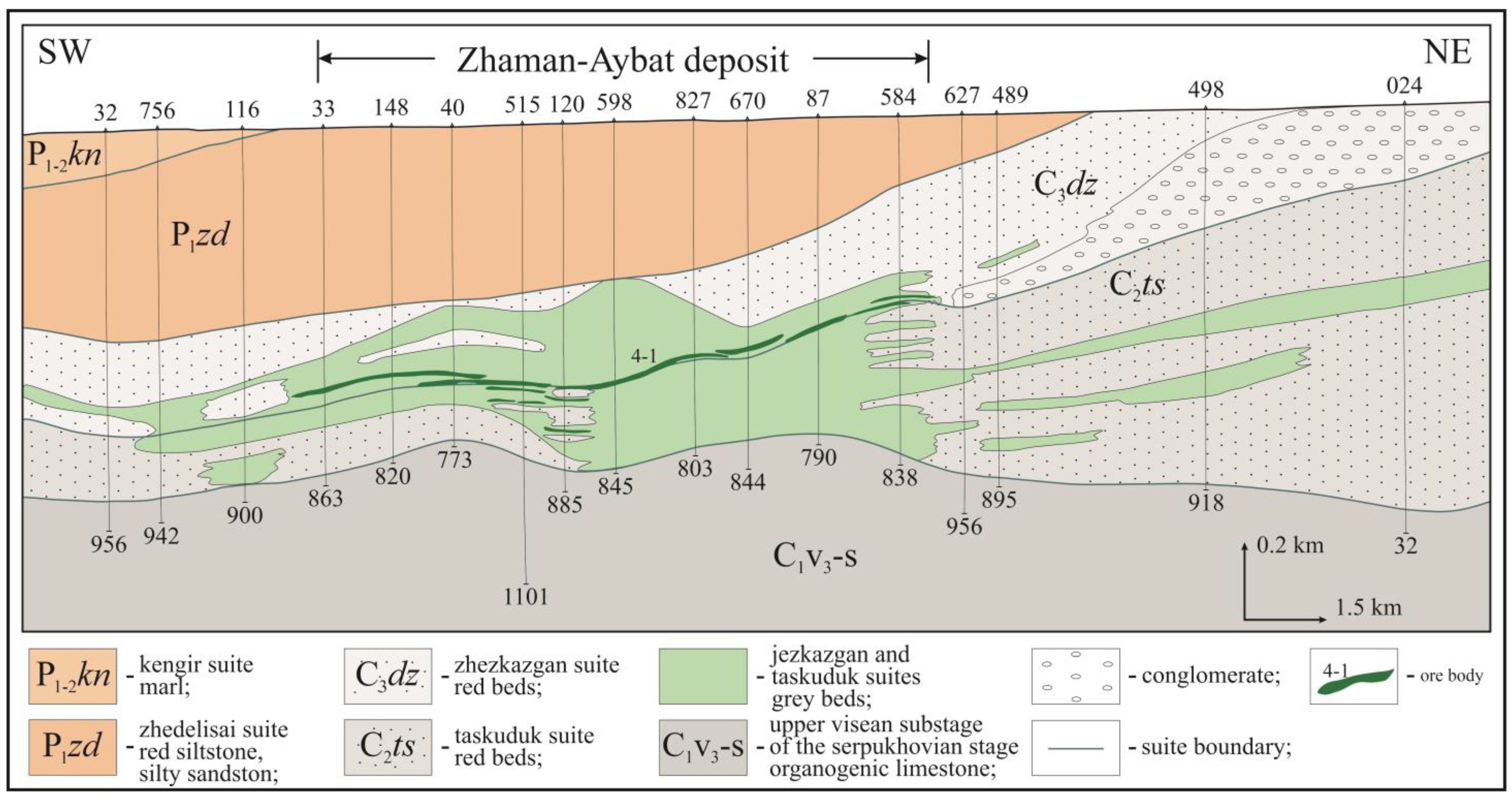

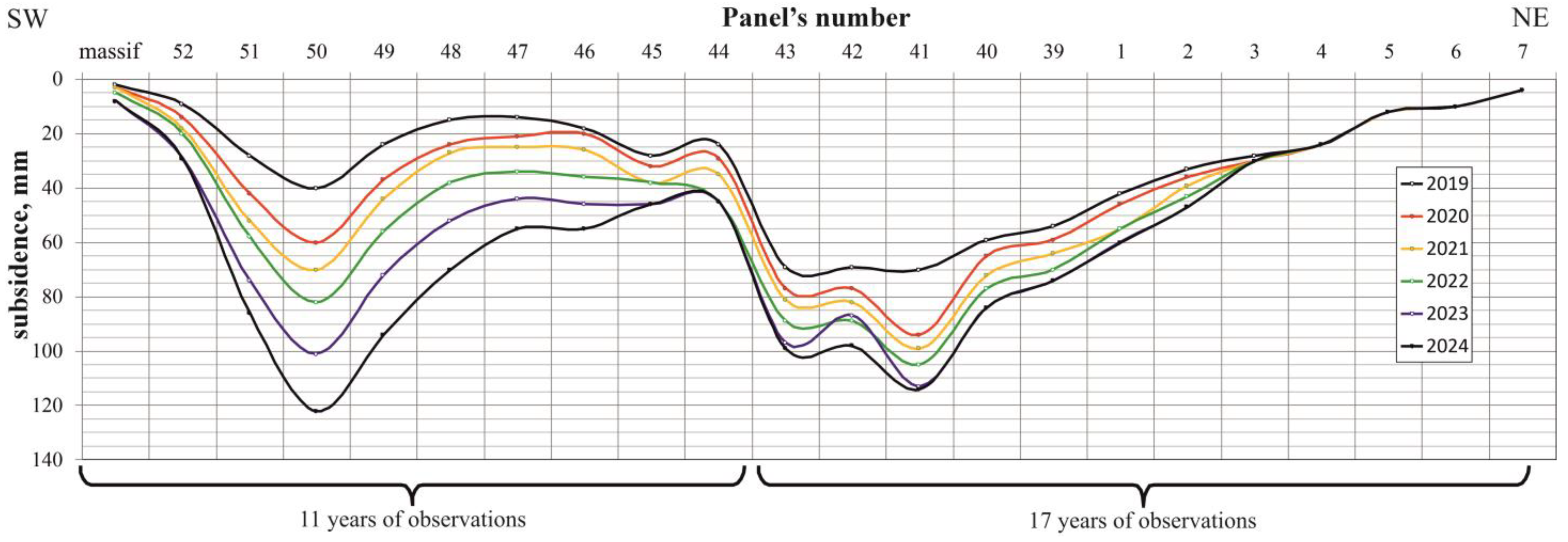

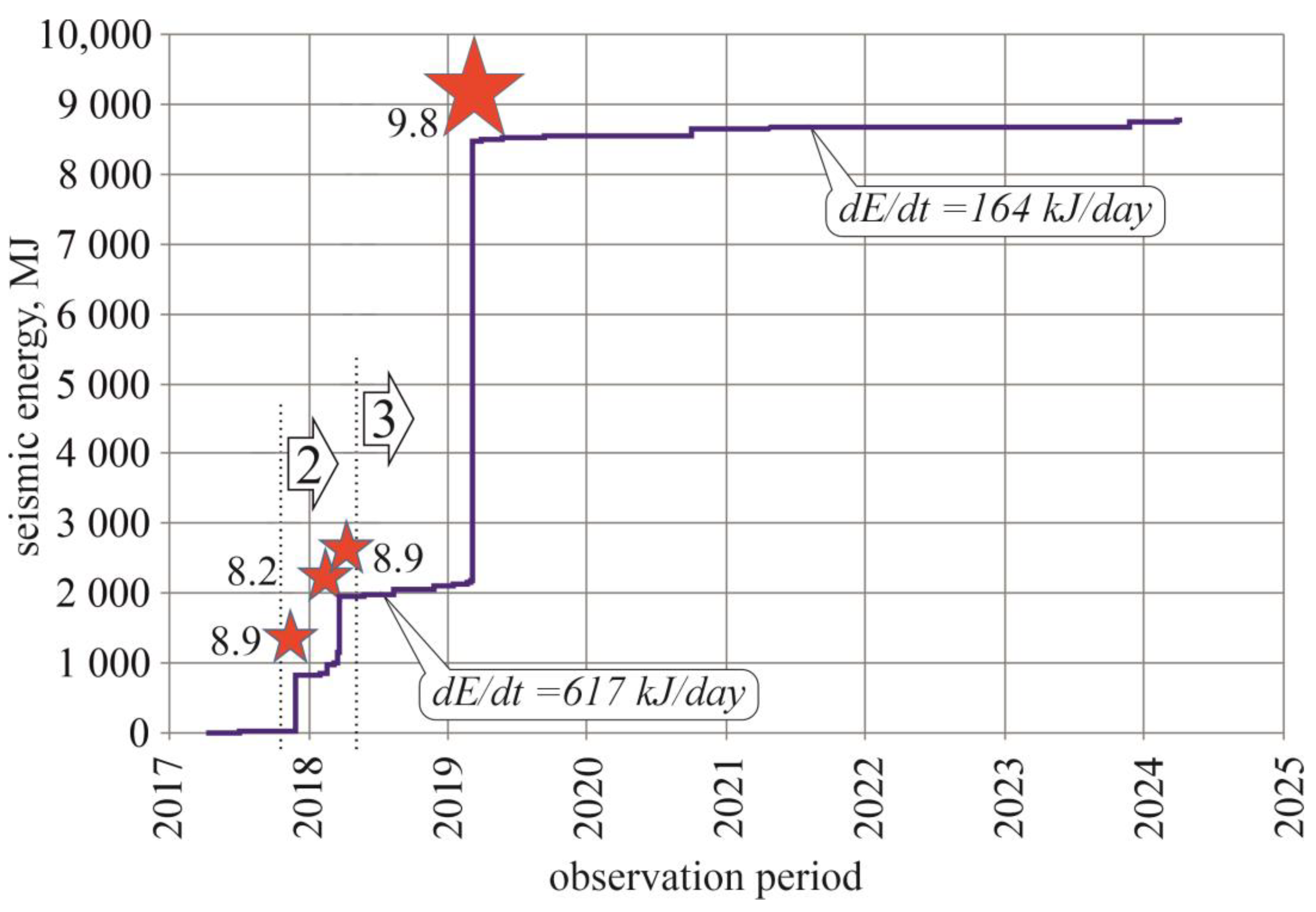
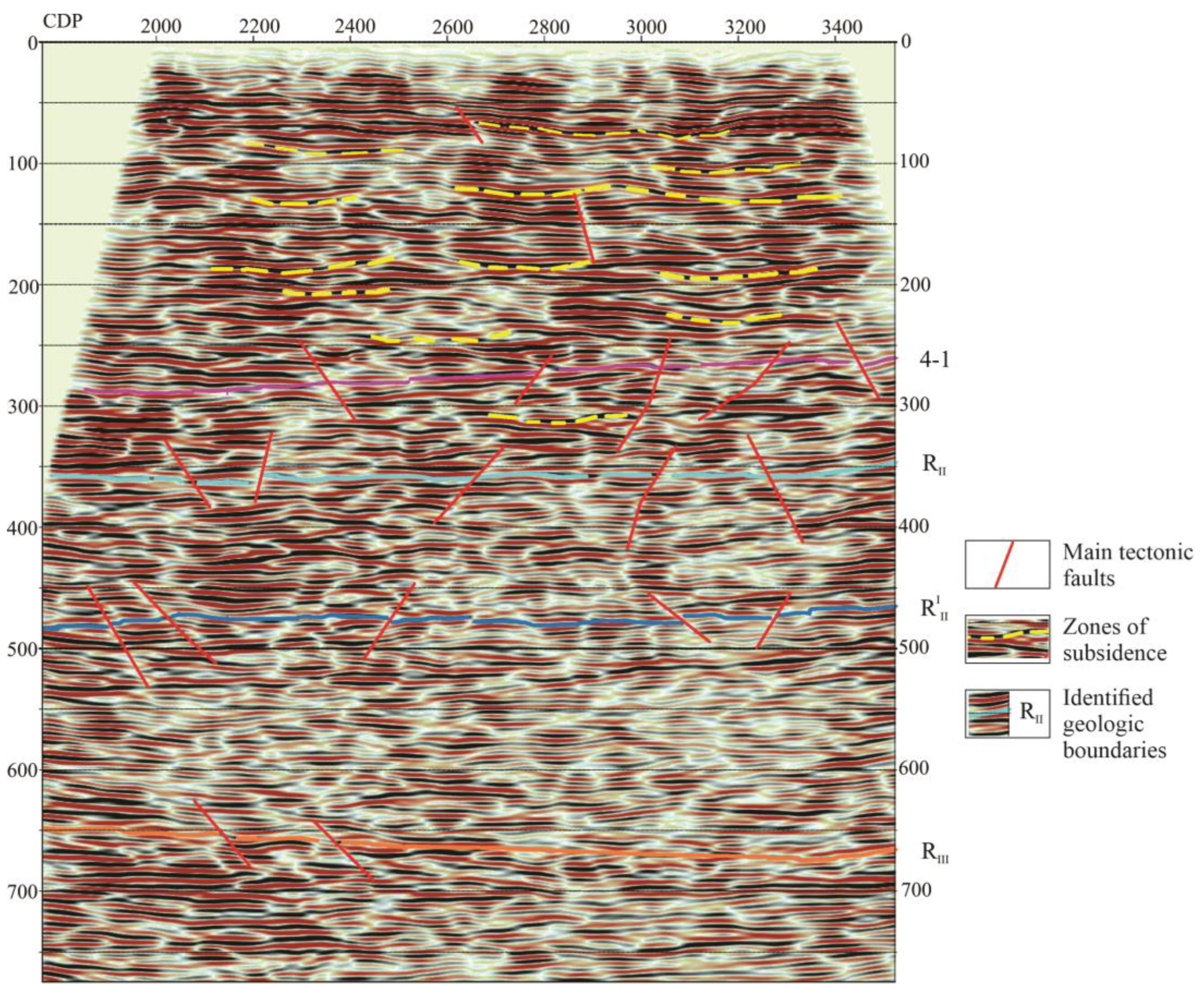


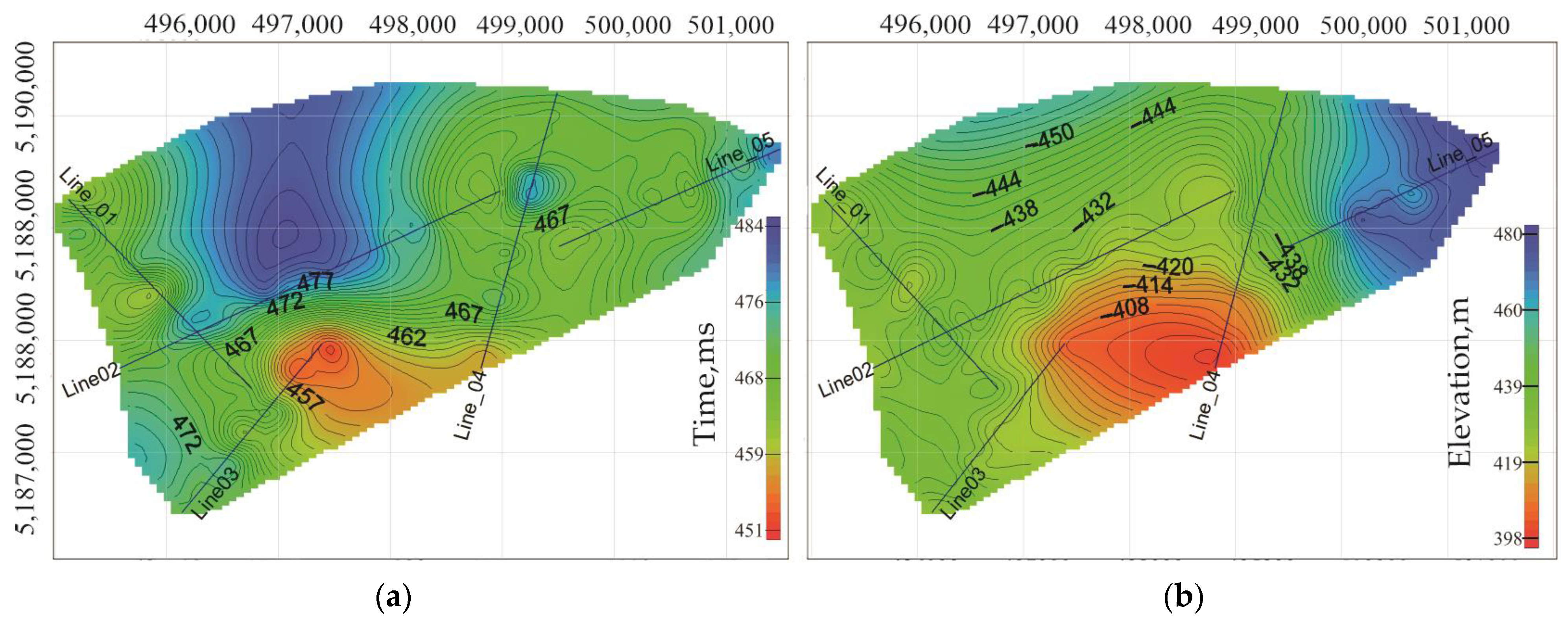
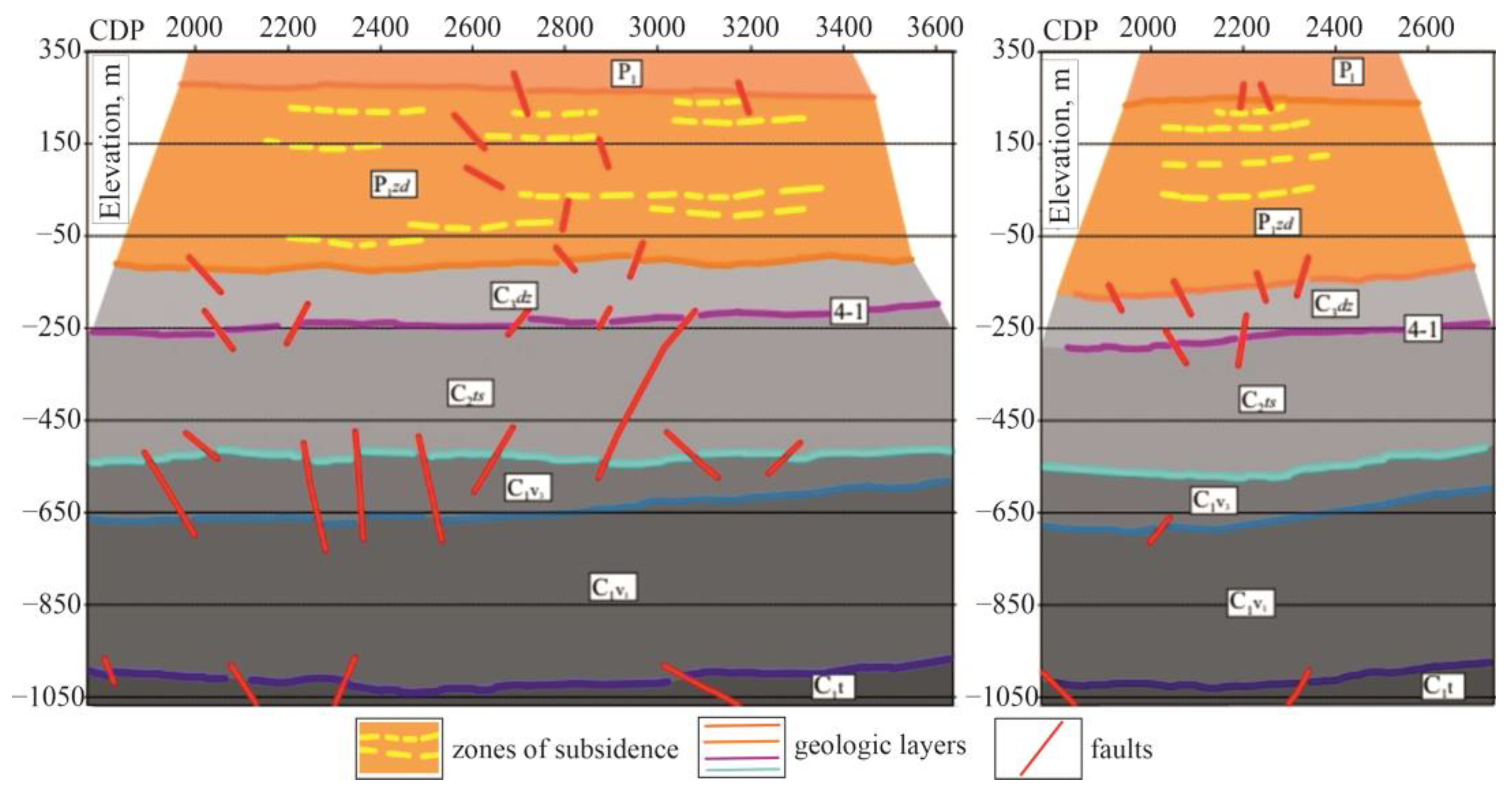
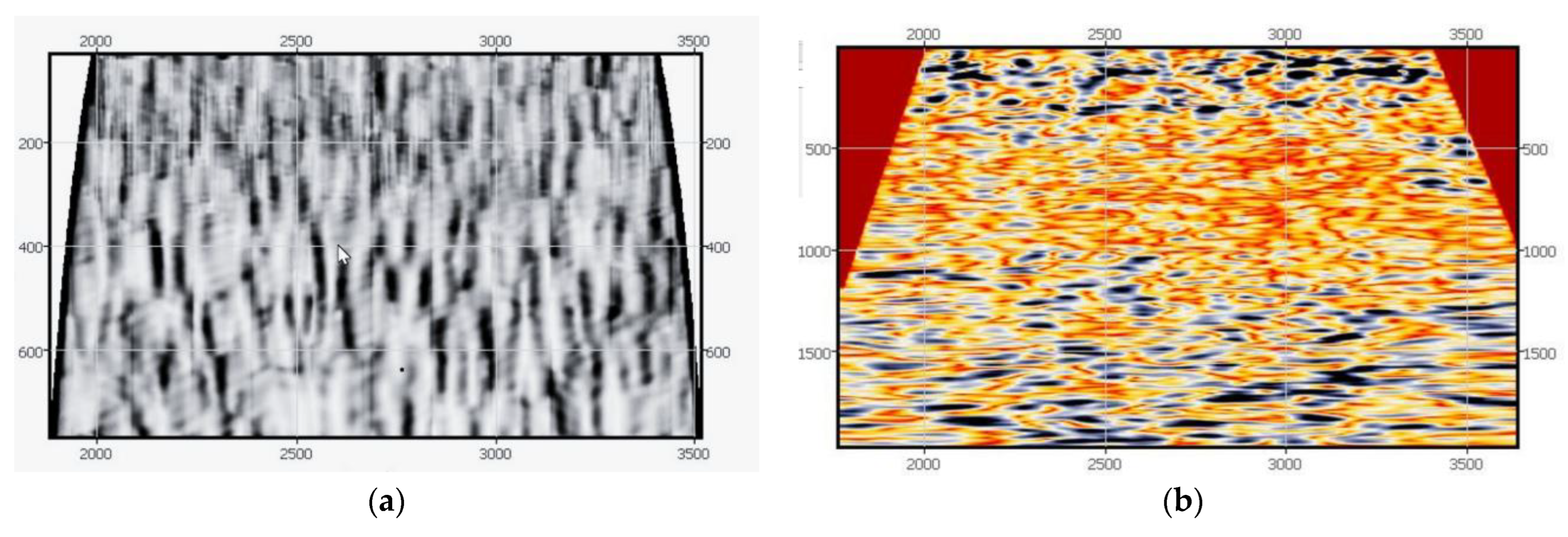
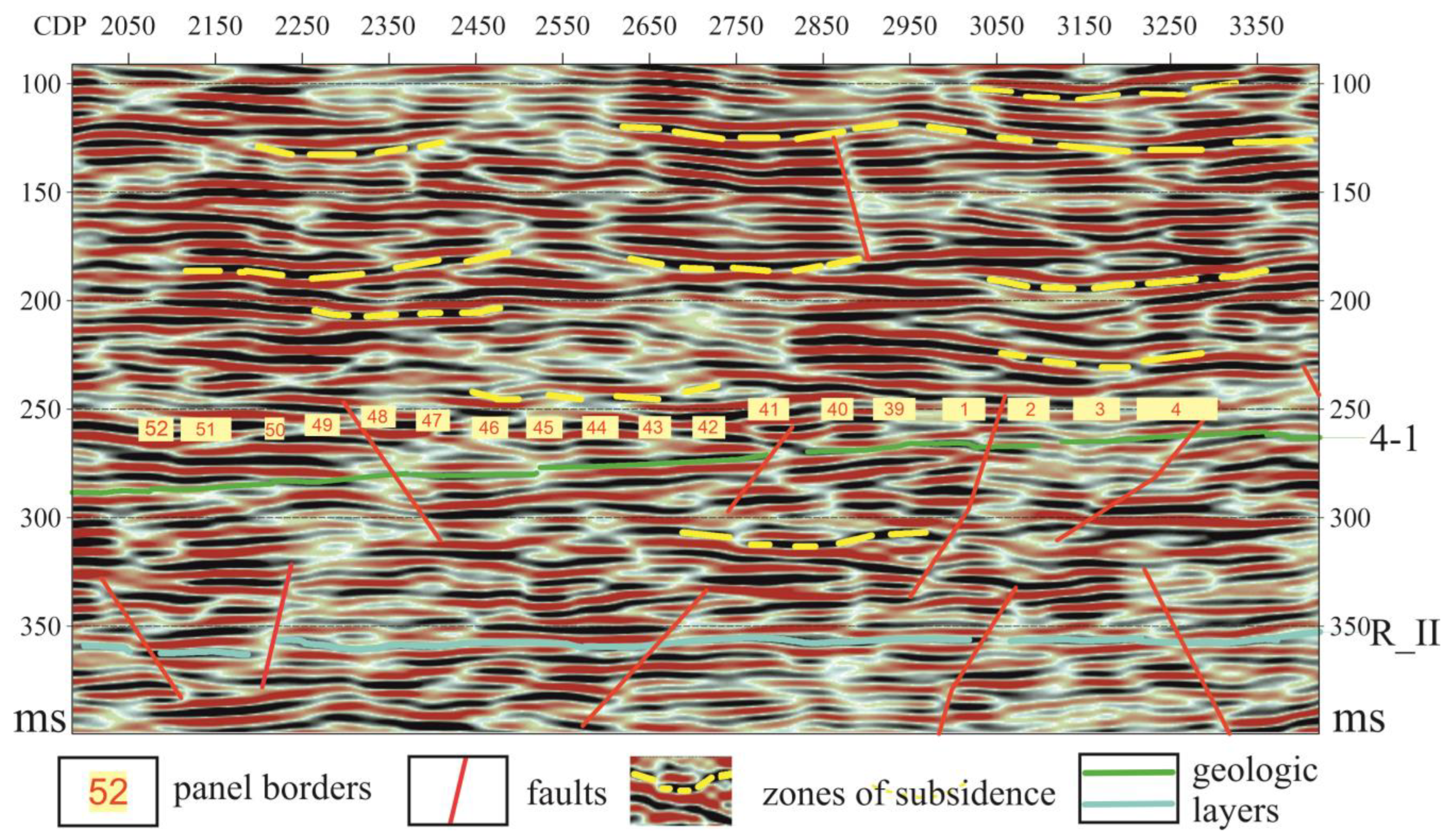
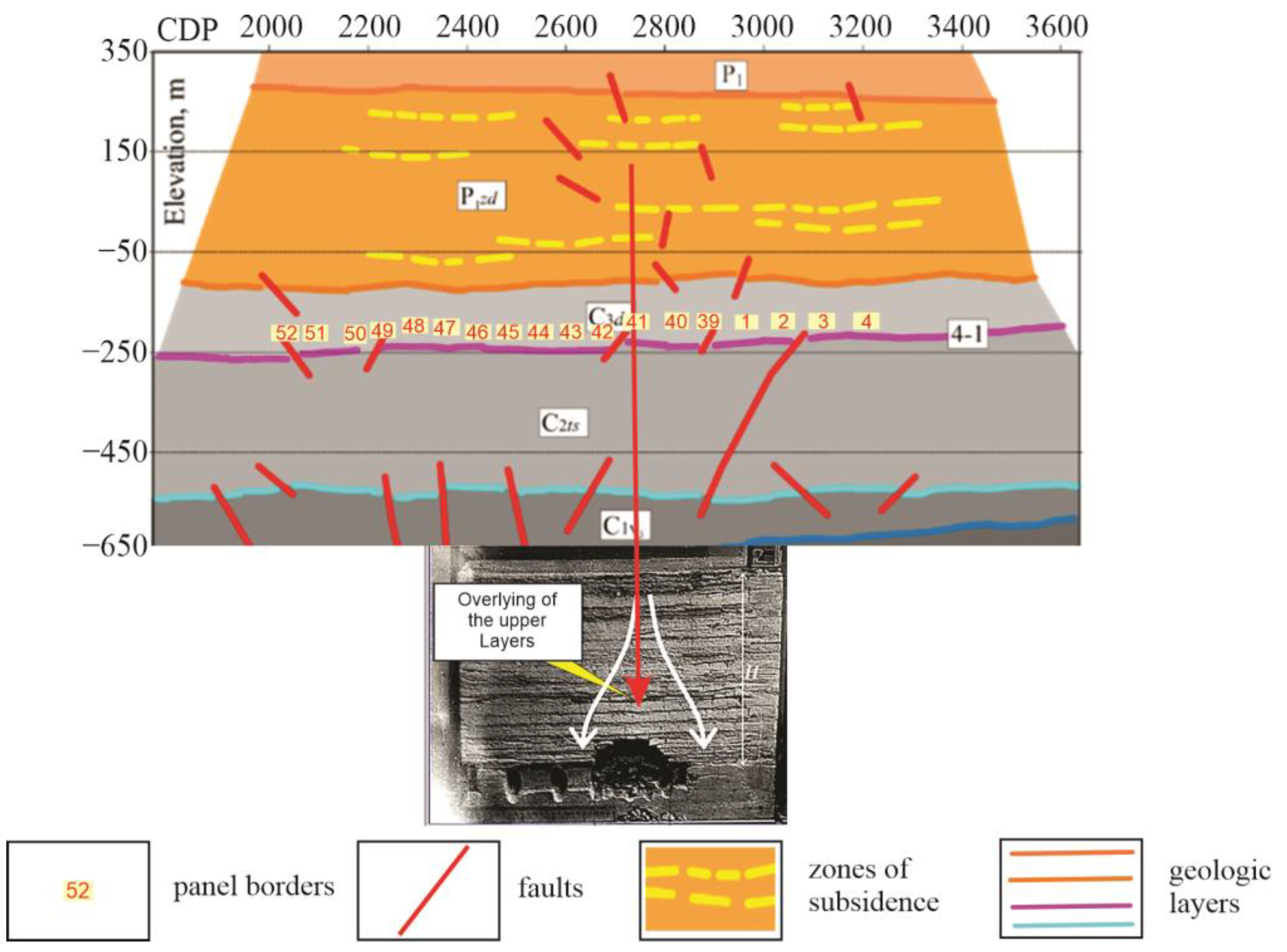

| Suite/Well Number | Velocity, m/s | |||||||||
|---|---|---|---|---|---|---|---|---|---|---|
| 158 | 164 | 187 | 216 | 219 | 225 | 03 | 015 | 025 | 024 | |
| P1zd | - | - | - | - | 1900 | 2600 | - | - | - | 1250 |
| P1zd | - | 1520 | - | 2450 | 2850 | 3500 | - | - | - | - |
| P1zd | 3150 | 3350 | 3150 | 3800 | 3850 | 4150 | 2500 | 4100- | - | 2860 |
| C3dz | 4400 | 4450 | 4300 | 4800 | 4950 | 4350 | 4330 | 5200 | 2860 | 4170 |
| 4800 | ||||||||||
| C2ts | 4400 | 4450 | - | 4500 | 4350 | - | 5000 | - | 4000 | - |
| 4700 | - | |||||||||
| C1vs | - | - | - | - | - | - | - | - | 5000 | |
| Two Way Travel Time, ms | Velocity, m/s | Computed Depth Based on Seismic Exploration, m |
|---|---|---|
| 100 | 3000 | 150 |
| 200 | 3500 | 350 |
| 300 | 4300 | 645 |
| 400 | 5200 | 1040 |
| 500 | 5700 | 1425 |
Disclaimer/Publisher’s Note: The statements, opinions and data contained in all publications are solely those of the individual author(s) and contributor(s) and not of MDPI and/or the editor(s). MDPI and/or the editor(s) disclaim responsibility for any injury to people or property resulting from any ideas, methods, instructions or products referred to in the content. |
© 2024 by the authors. Licensee MDPI, Basel, Switzerland. This article is an open access article distributed under the terms and conditions of the Creative Commons Attribution (CC BY) license (https://creativecommons.org/licenses/by/4.0/).
Share and Cite
Istekova, S.; Makarov, A.; Tolybaeva, D.; Sirazhev, A.; Togizov, K. Determining the Boundaries of Overlying Strata Collapse Above Mined-Out Panels of Zhomart Mine Using Seismic Data. Geosciences 2024, 14, 310. https://doi.org/10.3390/geosciences14110310
Istekova S, Makarov A, Tolybaeva D, Sirazhev A, Togizov K. Determining the Boundaries of Overlying Strata Collapse Above Mined-Out Panels of Zhomart Mine Using Seismic Data. Geosciences. 2024; 14(11):310. https://doi.org/10.3390/geosciences14110310
Chicago/Turabian StyleIstekova, Sara, Alexander Makarov, Dina Tolybaeva, Arman Sirazhev, and Kuanysh Togizov. 2024. "Determining the Boundaries of Overlying Strata Collapse Above Mined-Out Panels of Zhomart Mine Using Seismic Data" Geosciences 14, no. 11: 310. https://doi.org/10.3390/geosciences14110310
APA StyleIstekova, S., Makarov, A., Tolybaeva, D., Sirazhev, A., & Togizov, K. (2024). Determining the Boundaries of Overlying Strata Collapse Above Mined-Out Panels of Zhomart Mine Using Seismic Data. Geosciences, 14(11), 310. https://doi.org/10.3390/geosciences14110310







